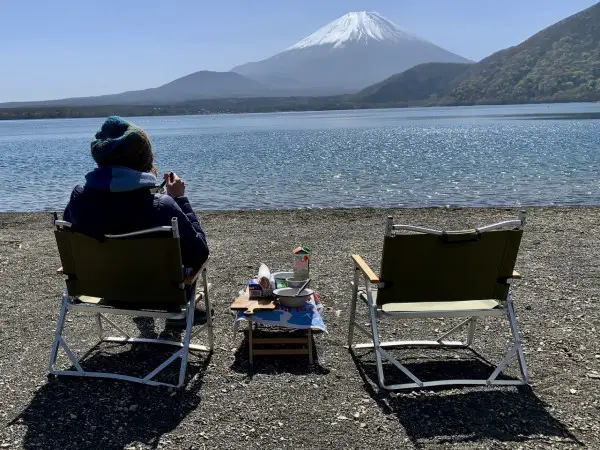
If you love spending time outdoors, there are so many beautiful places in Japan that it is very hard to find time to visit the same location more than once. Camping under Mount Fuji at the incredible campsite at Lake Motosu might be one of the exceptions. Pretty everyone knows that visiting Mount Fuji while traveling in Japan is a must, but hardly anyone is aware that camping under Japan’s most iconic peak is probably the best way to enjoy its magic. Let me share the details of this amazing campsite under Mount Fuji and why campervan travel in Japan is simply awesome.
What's in this blog post?
1. Camping under Mount Fuji at Lake Motosu
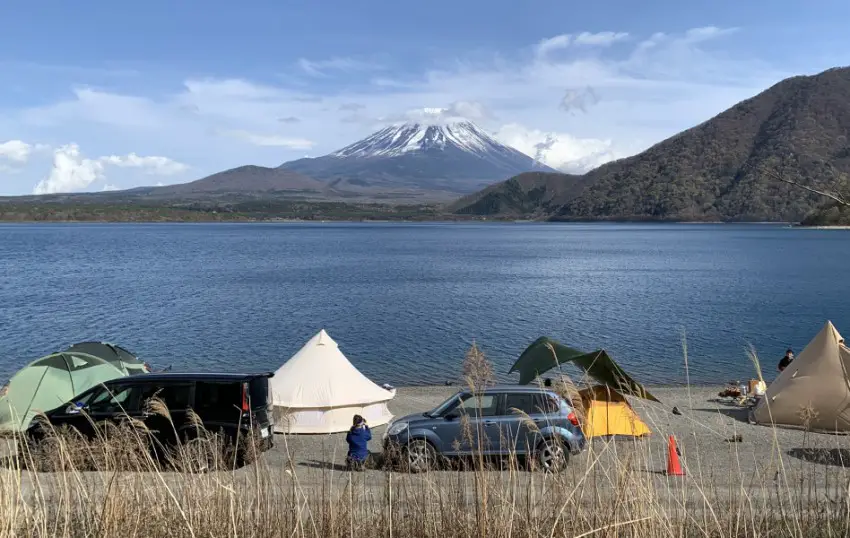
The Kouan Camping Ground is situated in Yamanashi Prefecture on the northern side of Lake Motosu (本栖湖), which is one of the Five Fuji Lakes – the most remote and mostly undeveloped. Apart from a few campsites around its shores and a handful of local restaurants, you will find nothing but nature around Lake Motosu and in cloudless weather a very starry sky at night.
The Kouan Camping Ground location is splendid. Situated at the lakeside, it boasts incredible views of Japan’s most iconic symbol – Mount Fuji. The massive volcano (3,776 m), surrounded by picturesque hills, sits just in front of your eyes, directly opposite on the other side of the lake. Lake Motosu is my favorite location to experience the powerful magic of Mount Fuji. To tell the truth, the Kouan Camping Ground is my favorite place in all of Japan. In the last 12 months alone, I visited it three times and I don’t usually return to the same place… I guess it means true love, which… I want to share with you now!
1.1. My favourite campsite: the Kouan Camping Ground
The Kouan Camping Ground offers two types of accommodation: tent sites and cabins. The campsite reception, a small gift shop and the restaurant usually open for lunch only (but temporarily closed due to the pandemic) are all located in the main building by the road. Coin-operated showers, toilets, a roofed washing area to clean up the dishes and a little shop with camping essentials open only in the most busy season are situated at the campsite by the lake.
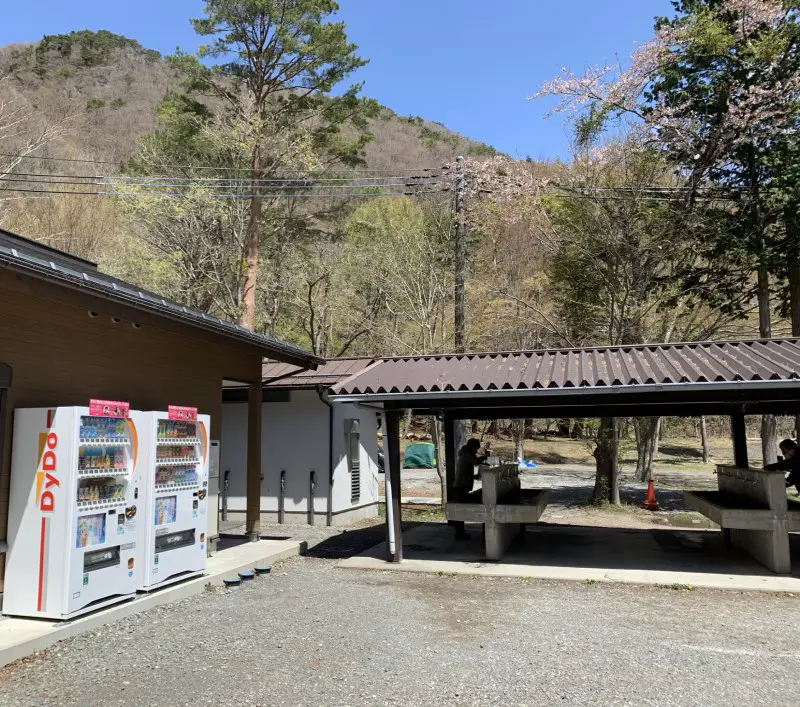
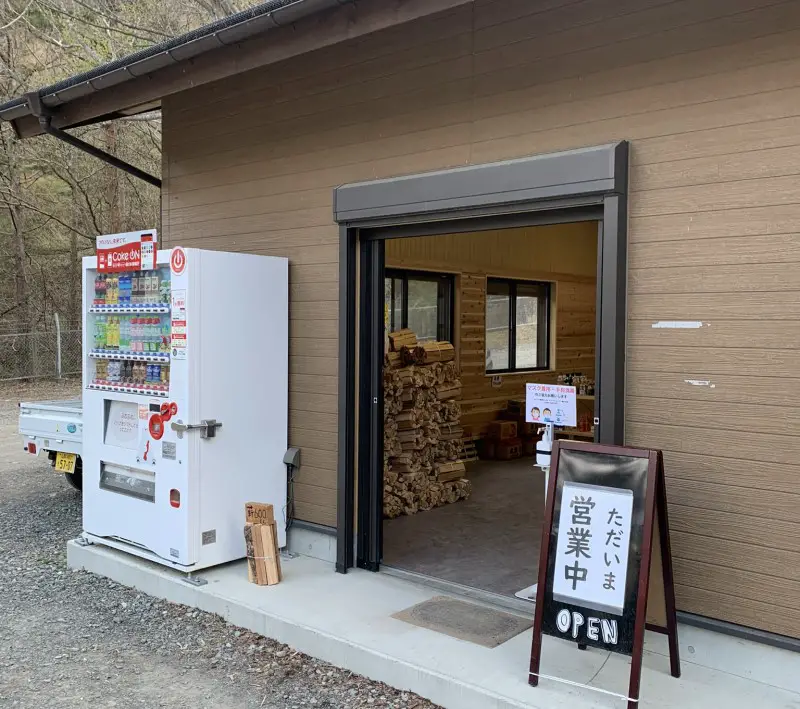
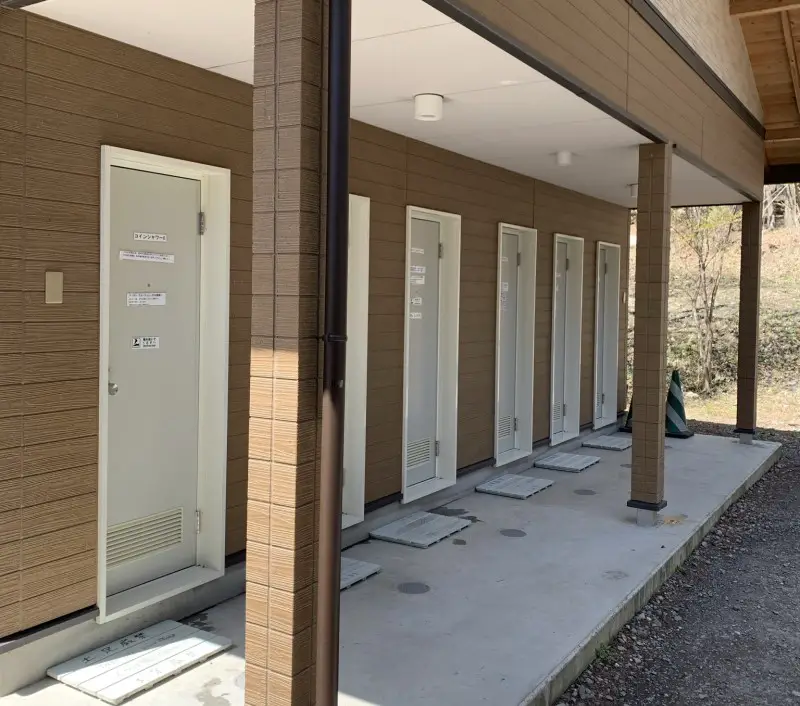
The Kouan Camping Ground is a friendly environment for both beginner and professional campers where you can come with a campervan or a tent and find everything you need. At the reception we were always able to communicate in English, the gift shop is equipped with basic camping gear, including firewood and the fire can be made directly on the ground – you don’t need to bring a fire pit.
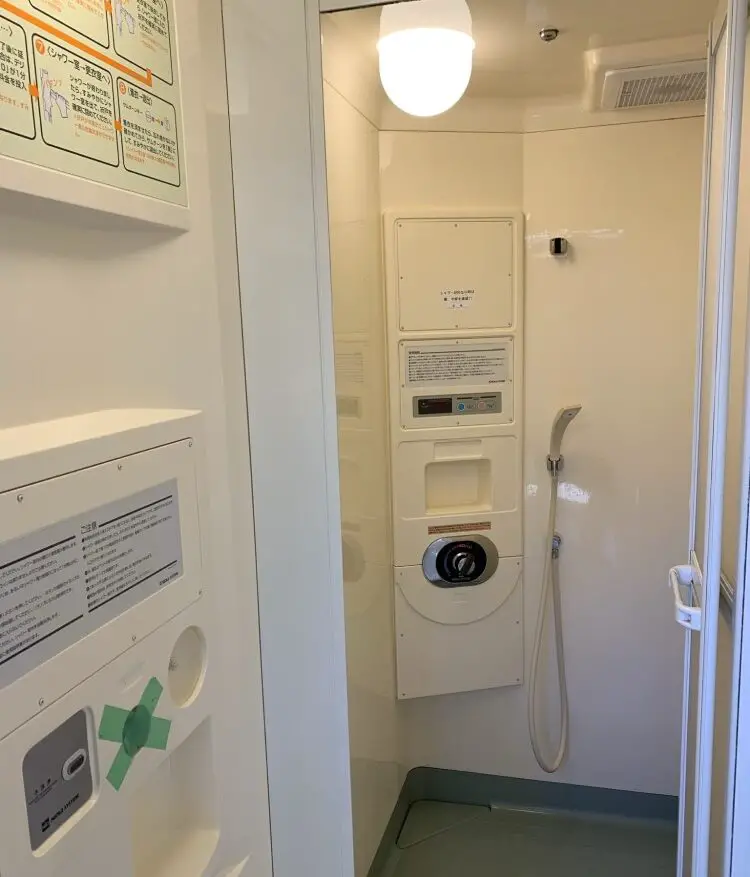
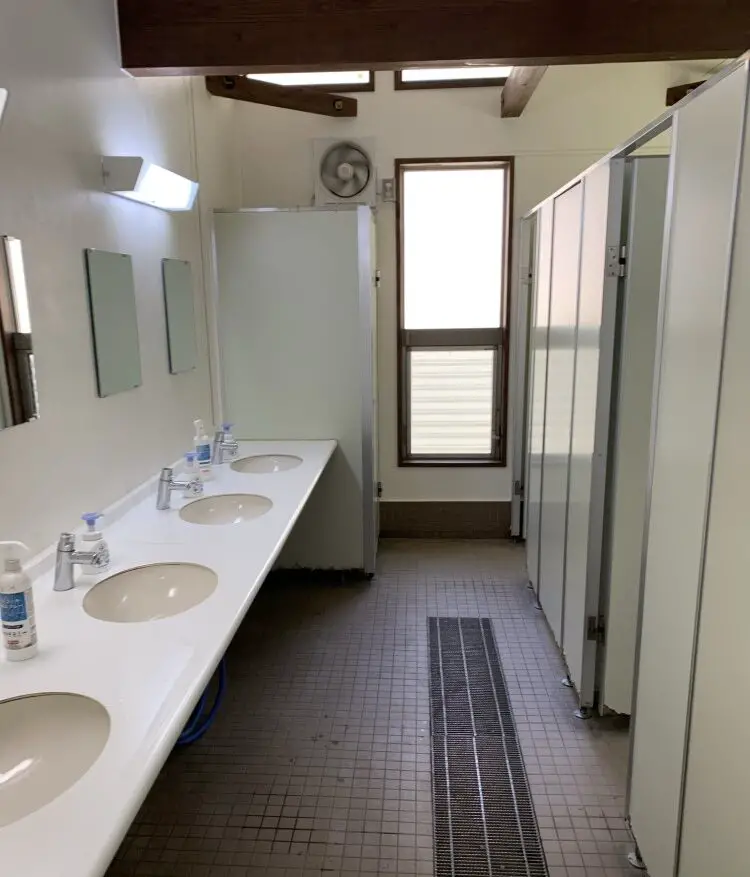
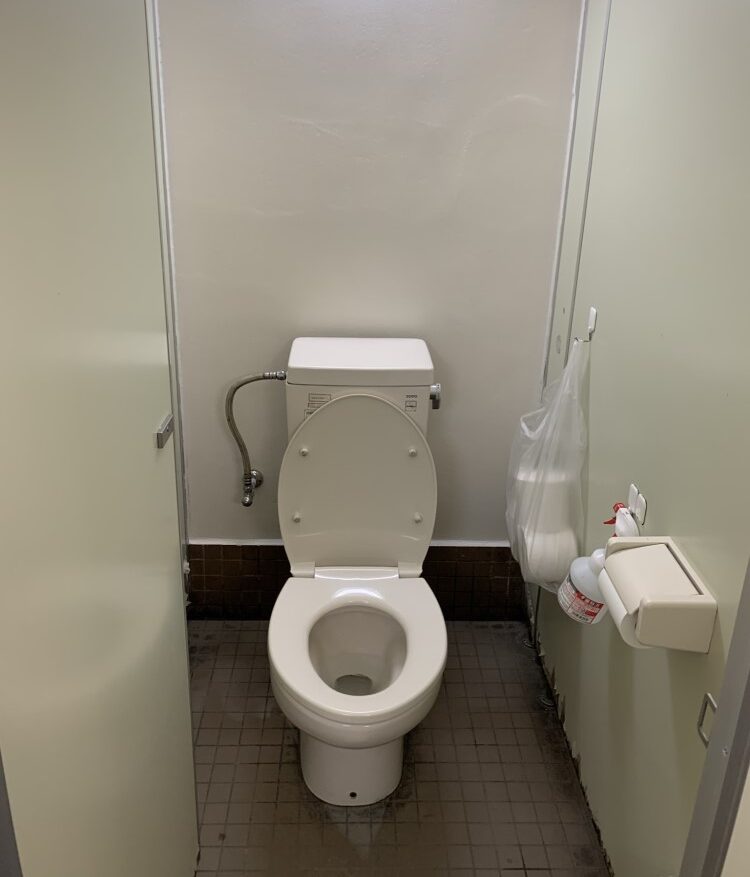
It takes a little bit more than 2 hours to travel by car from Tokyo to the campsite (~130 km), if there is no traffic jam. Getting to Lake Motosu by public transportation is difficult but not impossible. First, you have to get to Lake Kawaguchi, which can be easily reached from Tokyo by both train or bus, and then take the local bus to Lake Motosu. Visit this website for more details: Japan-guide.com
1.2. Online booking & prices
Until recently, the Kouan Camping Ground did not accept reservations for tent sites, which changed last autumn. Especially on weekends, the campsite is busy, so booking in advance is a good idea. Reservations can be made via the website up to 60 days before the check-in date.
What’s interesting and not so uncommon in Japan, although the official website of the campsite is also available in English, bookings can only be made on the Japanese website, at least for the moment. But don’t worry – it’s pretty easy with Google Chrome English translator. Just switch to the original Japanese website when selecting the check-out date, otherwise you will get a “NaN/NaN/NaN” error.
One thing to note, the Kouan Camping Ground does not have numbered sites, so you will choose your exact spot only after your arrival, therefore it’s always better to arrive early.
Campsite prices vary depending on the time of arrival and the size of the car. The maximum total cost of one night is:
- 2 people with a large campervan: 900 JPY/ person + 2400 JPY/vehicle = 4200 JPY
- 2 people with a tent and a car: 900 JPY/person + 1200 JPY/ tent + 1200 JPY/car = 4200 JPY
- 16,000 JPY for the smallest 4-people cabin and 49,000 JPY for a 10-people cabin.
Weekday prices are slightly lower. A day camp stay with a check-out at 5 PM is also possible.
1.3. Useful links
(Note that on Google Maps, the name of the campsite is spelled a bit differently – Koan Camping Ground 浩 庵 キ ャ ン プ 場 )
2. Campervan travel in Japan
So far, I visited Lake Motosu three times and always stayed in a rented campervan. I fell in love with this kind of travel when visiting Australia and New Zealand as it gives extreme freedom and is more comfortable compared to a tent stay. Especially on a windy day when other people spend half a day trying to pitch their tents (although I think it’s part of the fun and you can love it), I’m already relaxing sipping coffee with a fantastic view of Mount Fuji.
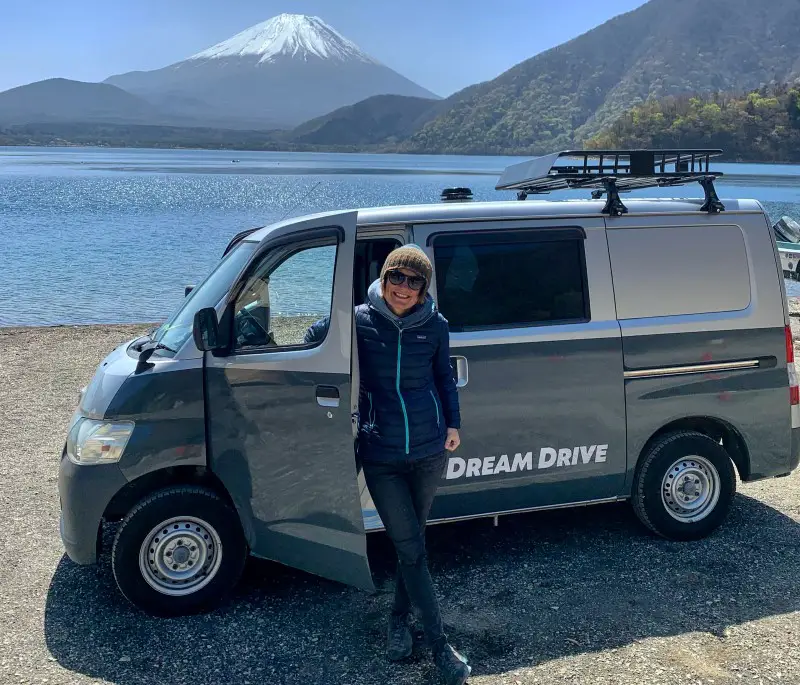
But traveling in Japan in a campervan? Although it might not be very popular as most of the people choose famous shiny bullet trains, paradoxically, “Land of the Rising Sun” is a perfect destination for campervan travels. Why?
First, over 70% of Japan’s territory is covered by forests and mountains. Access to the most beautiful natural wonders is much easier by car than by public transport. Second, Japanese infrastructure is perfect for campervan travel. Public toilets are spotlessly clean, public baths and hot springs can be found everywhere, road stations called “Michi no Eki” offer all the conveniences while on the road, and the roads are good and very scenic. Third, exploring Japan in a campervan is usually cheaper than traveling in trains and staying in hotels. The petrol prices are relatively low. Lastly, Japan is a super safe country so sleeping in the campervan in a parking lot does not pose risks.
Betiful World in Campervan
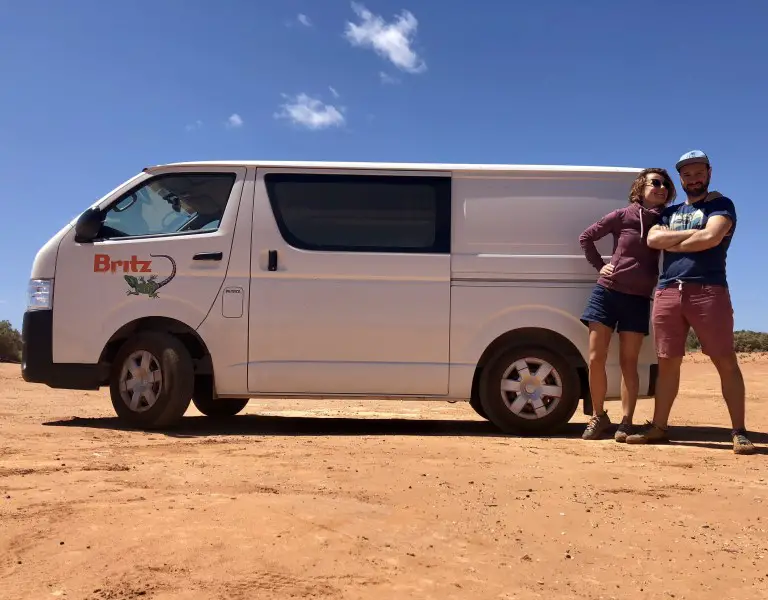
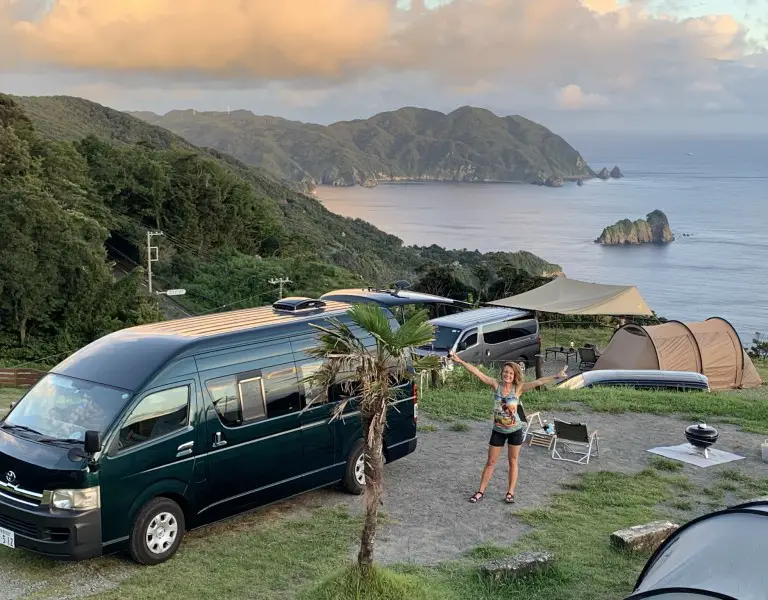
Convinced? If still not, the amazing Dream Drive campervan offer will dispel any remaining doubts. I promise 🙂
2.1. Campervan rental details
When going camping under Mount Fuji I choose Dream Drive’s offer twice out of three. I will most probably do it again if I have another chance. Why? Well, just check out this photo.
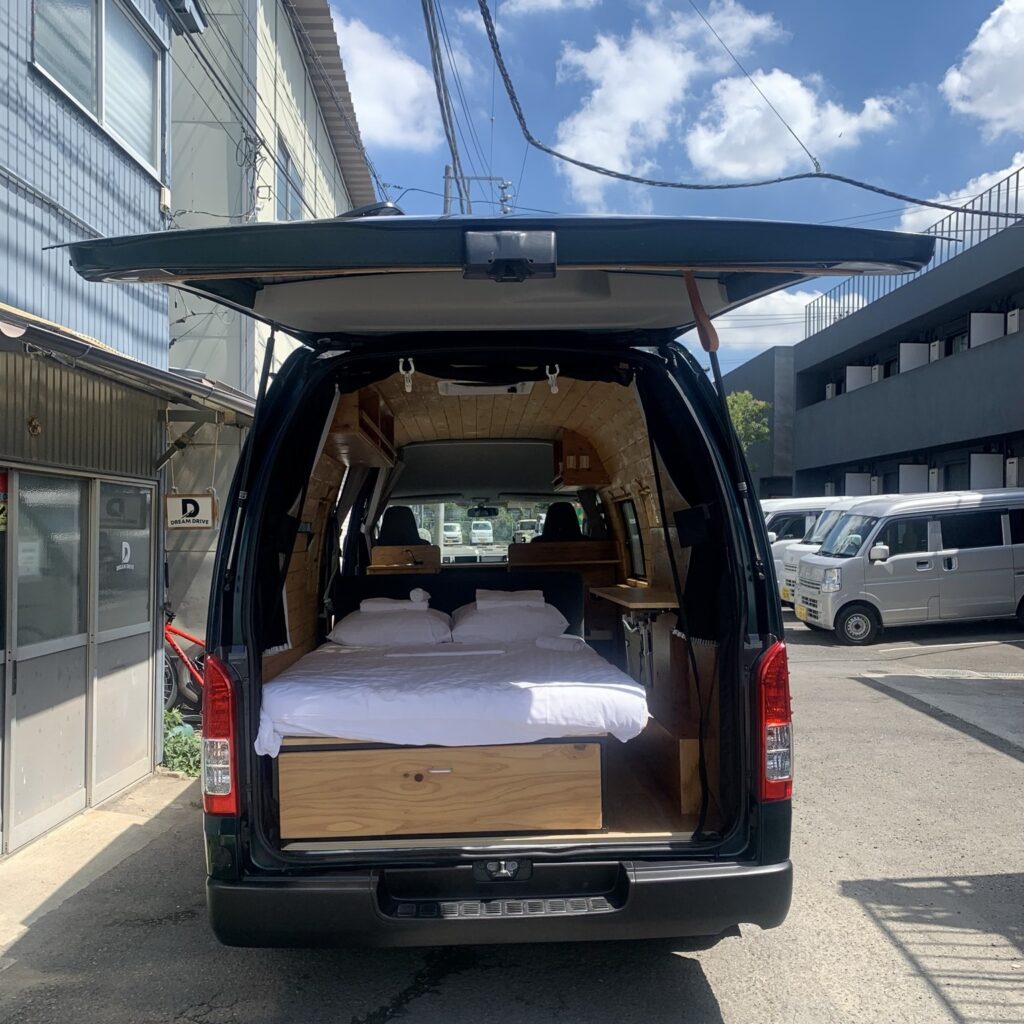
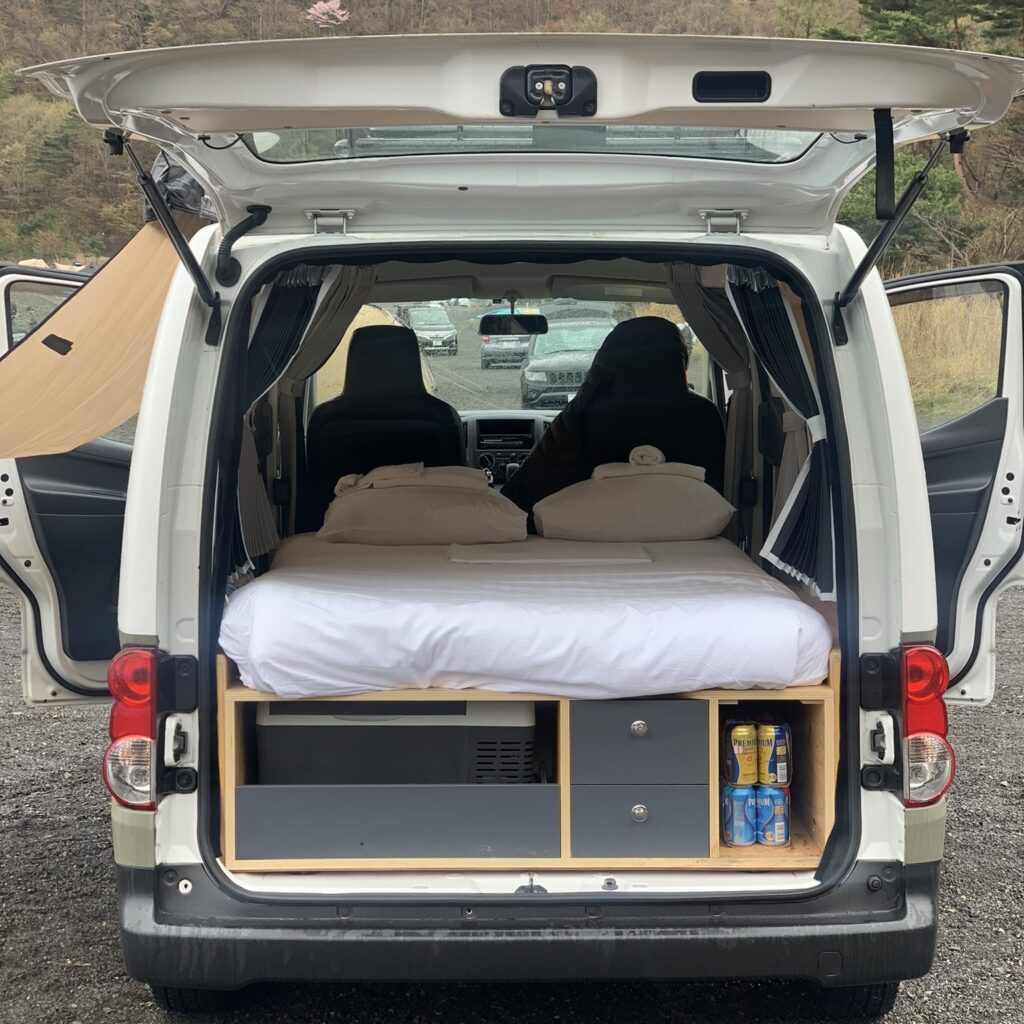
Unique design, wood panel interiors, many useful features and a full-size foam mattress like in a good quality hotel. Even if Mount Fuji is hidden behind the clouds, your trip in such a beautiful and comfortable campervan will always be a blast.
Online booking as well as communication in English with the easy-going Dream Drive team have always been smooth.
2.2. Dream Drive campervan prices
If you look at Dream Drive prices, they might initially seem a bit higher than what other rental companies offer in Tokyo, but that’s a little misleading. When renting from Dream Drive, everything is already included in the price (a warm duvet covered with white linen, towels, a small table and two chairs, a mini fridge and a portable gas stove as well as all necessary kitchen utensils). While in most cases you have to pay extra or bring your own. In addition, you can’t beat the Dream Drive’s stylish design and comforts if you travel in two people.
The cost of renting a Dream Drive campervan, which can accommodate 2 adults, for 3 full days and 2 weekend nights with extra charges for early pick up at 10AM (regularly 3PM) and late return by 6PM (instead of 12PM) included in the price ranges from approximately 35,000 to 55,000 JPY depending on the car.
DREAM DRIVE USEFUL LINKS:
2.3. Renting a different campervan
I have once rented a cheaper campervan from another rental company and the car’s condition left a bit to be desired. It was just an older vehicle. In addition, sleeping in a sleeping bag couldn’t be compared to a night spent in white sheets on the comfortable Dream Drive bed. However, if you want to save some money, or there are more than two of you, other rentals may be a better option. Camping under Mount Fuji will be an unforgettable experience, no matter what car you come by.
3. What to do at Lake Motosu?
Sitting in a comfortable camping chair with a hot cup of coffee in your hand while admiring the perfect white cone of majestic Mount Fuji all day long is incredibly tempting. But there are some interesting spots to visit around Lake Motosu, so if you manage to get up from your chair, you will not regret it. Here is the list.
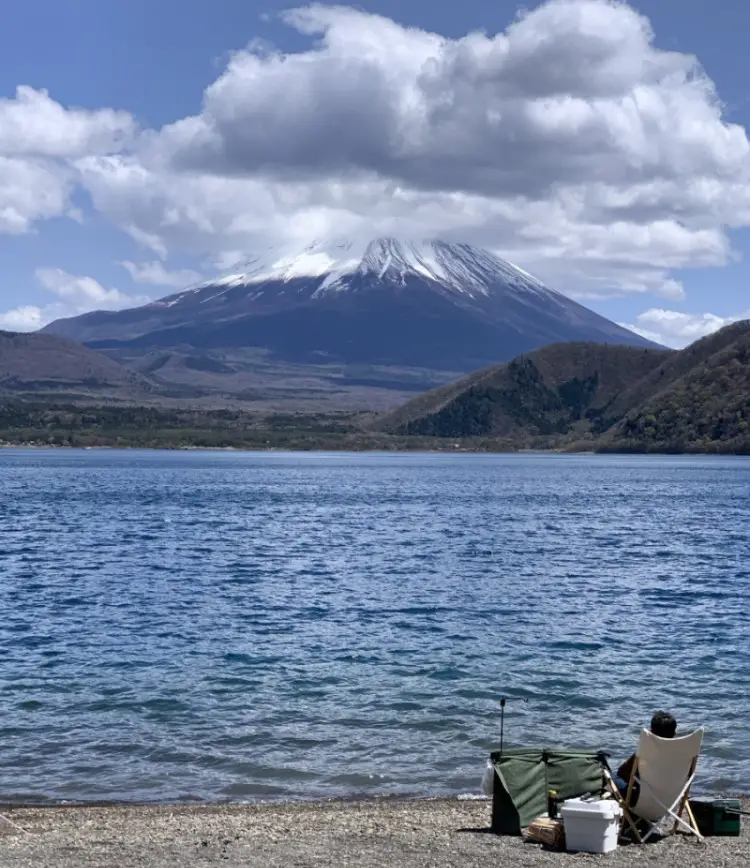
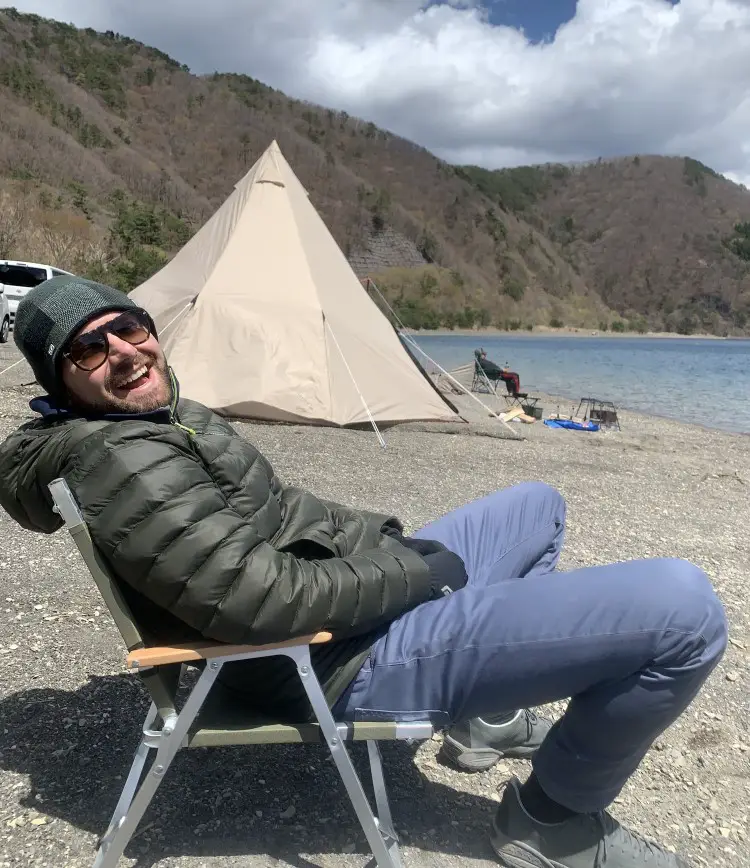
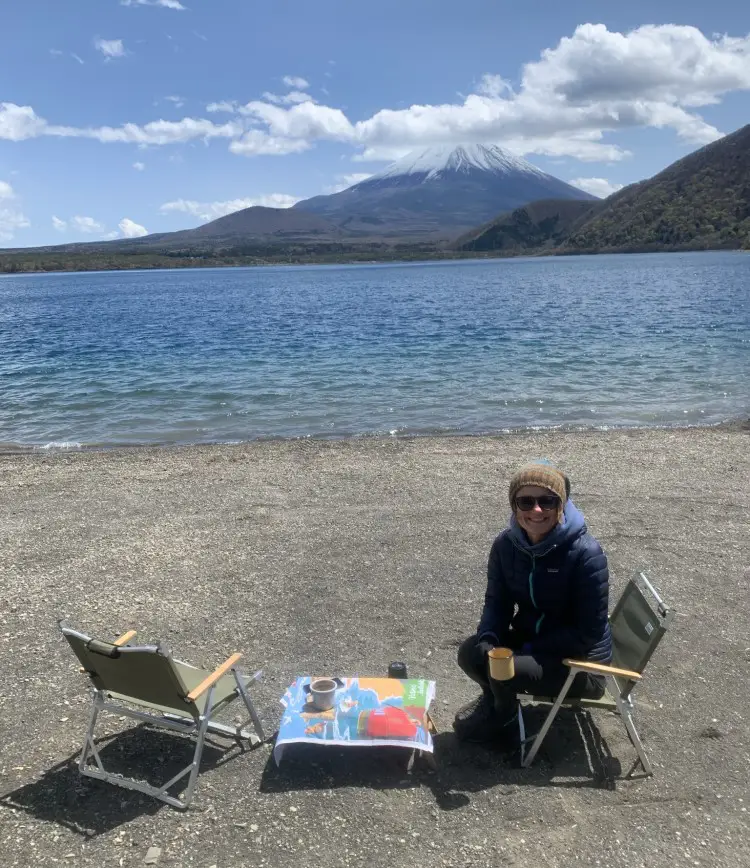
Lake Motosu Beach
A pleasant stroll along the 1-km beach at the campsite is simply a must. This scenic beach is partially overtaken by campers, who are always fun to watch, but there is also a big part of the beach where cars and tents are not allowed.
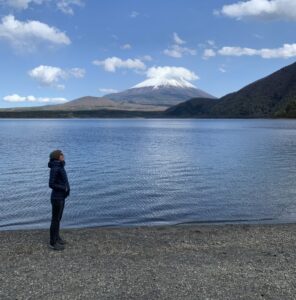
A short hike to the famous Mount Fuji 1000 yen note spot
Lake Motosu is perhaps best known for its appearance on the back side of the 1000 yen note. The exact spot where the famous image comes from is the Nakanokura Pass viewpoint, conveniently located just behind the Kouan Camping Ground. It’s a short 30-minute hike from the parking lot to the viewpoint.
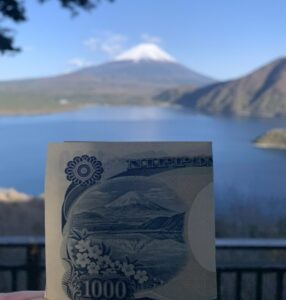

A short hike to the famous Mount Fuji 1000 yen note spot
Lake Motosu is perhaps best known for its appearance on the back side of the 1000 yen note. The exact spot where the famous image comes from is the Nakanokura Pass viewpoint, conveniently located just behind the Kouan Camping Ground. It’s a short 30-minute hike from the parking lot to the viewpoint.
You can leave your campervan or tent at the campsite and take a beautiful walk. In good weather, especially in the early mornings, Mount Fuji’s reflection on the lake’s surface can be seen from the viewpoint, just like on the banknote. Even though I didn’t wake up early enough to see the reflection, the view was spectacular.
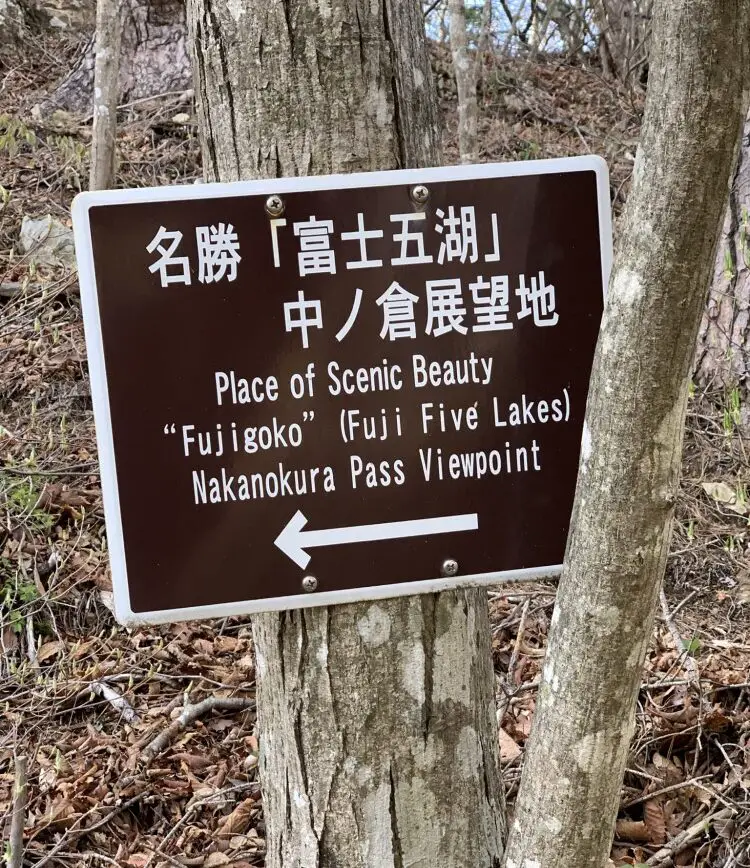
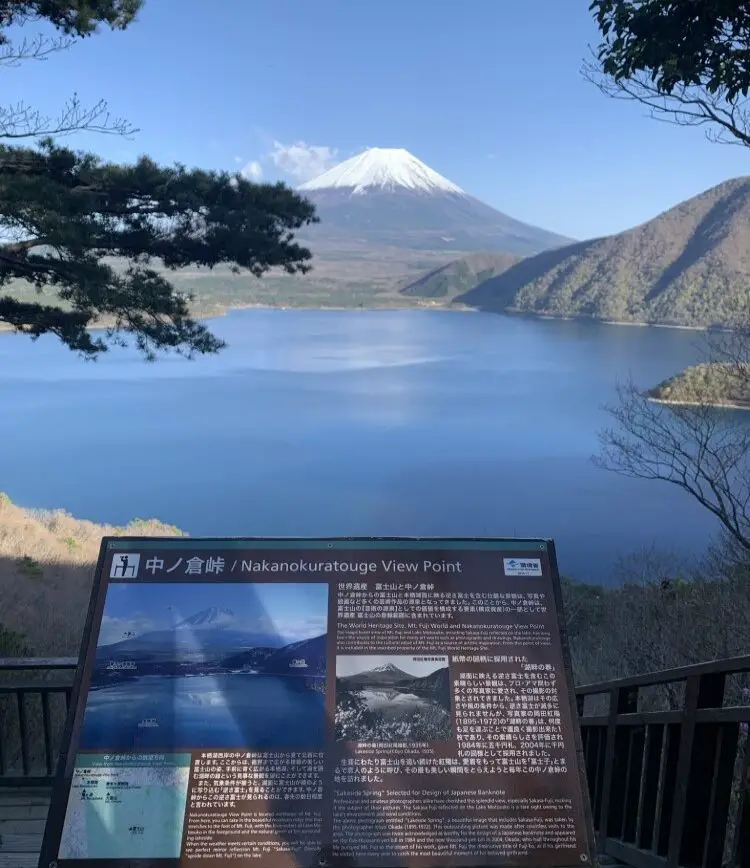
For more ambitious hikers, there is a 4-km trail (one way) from the Nakanokura Pass viewpoint, leading to the smallest of the Fuji Five Lakes – Lake Shoji.
Fuji Shibazakura Festival
Even though I’m not a big fan of popular flower festivals in Japan, as they usually attract crowds, and I prefer wild nature anyway, I must admit that this bright pink flower rug under Mount Fuji looks very pretty. Well, anything set against the backdrop of Mount Fuji looks good, doesn’t it?
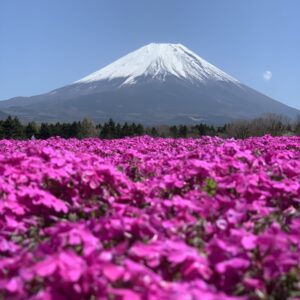
Fuji Shibazakura Festival is held every year near Lake Motosu. The flowers usually bloom from the second half of April and the end of May. I got there at the beginning of the festival around April 20 and the flowers were not in full bloom yet. The best time to see the pink moss coincides with the Golden Week holidays in early May, which means large crowds as well.
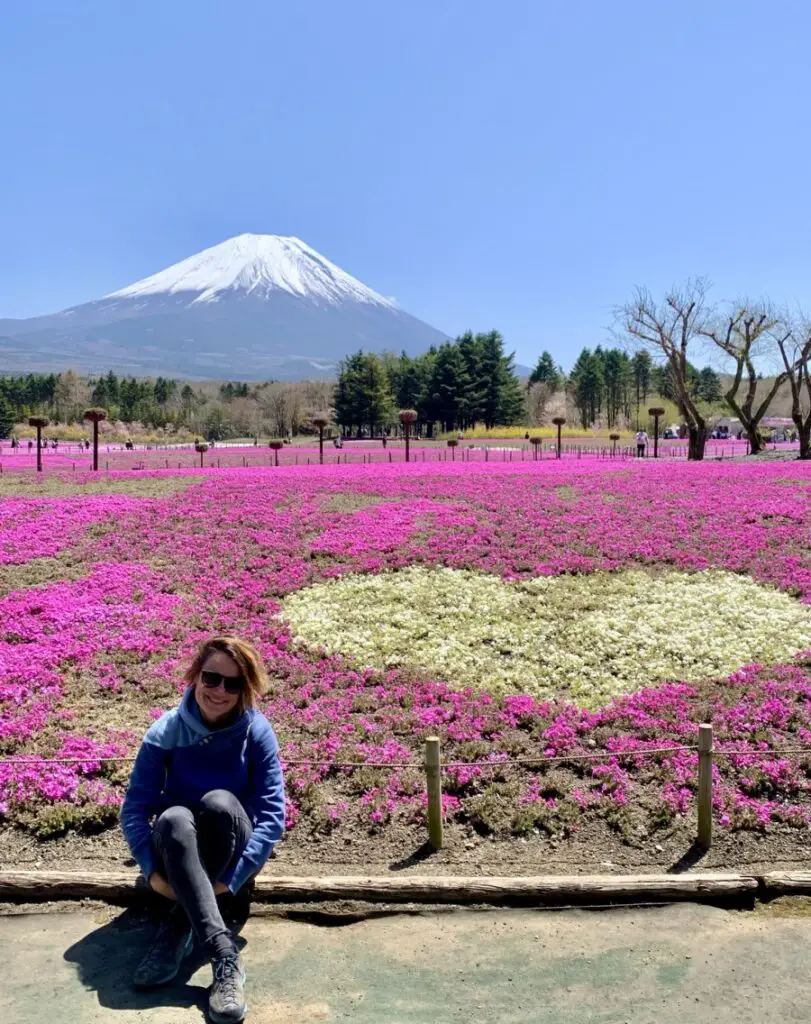
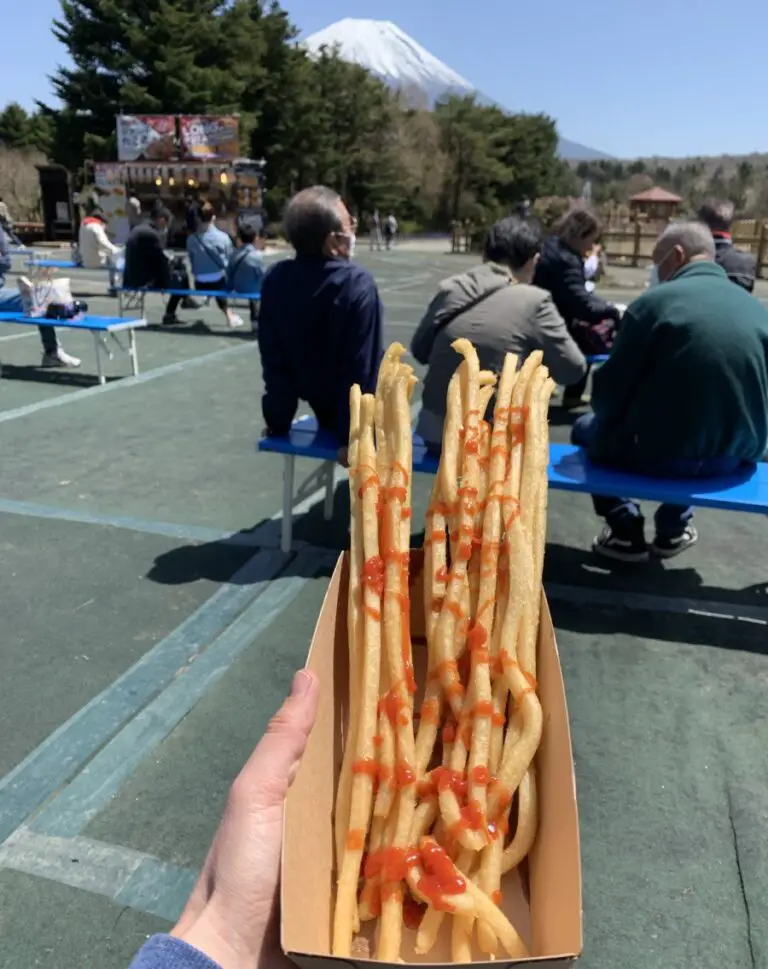
Festival stalls sell pots of pink moss, souvenirs as well as food and local snacks. The admission fee varies from 800-1000 JPY depending on the state of the blooming season. Parking fee is 500 JPY.
Eat a traditional hōtō soup
Visit a local restaurant on Lake Motosu to taste the most famous dish of Yamanashi Prefecture – hōtō soup, which is a combination of flat noodles and vegetables served in a traditional Japanese miso soup cooked with dashi broth and soybean paste.
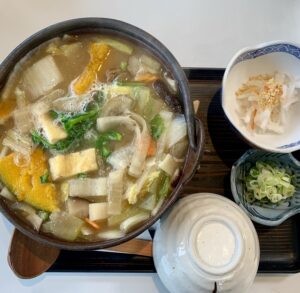

Eat a traditional hōtō soup
Visit a local restaurant on Lake Motosu to taste the most famous dish of Yamanashi Prefecture – hōtō soup, which is a combination of flat noodles and vegetables served in a traditional Japanese miso soup cooked with dashi broth and soybean paste.
I had it twice in the same restaurant called 湖 仙 荘, which should be read “Kosenso”. The soup was delicious and the service lovely. I’ve marked the exact location on the map at the bottom of this blog post.
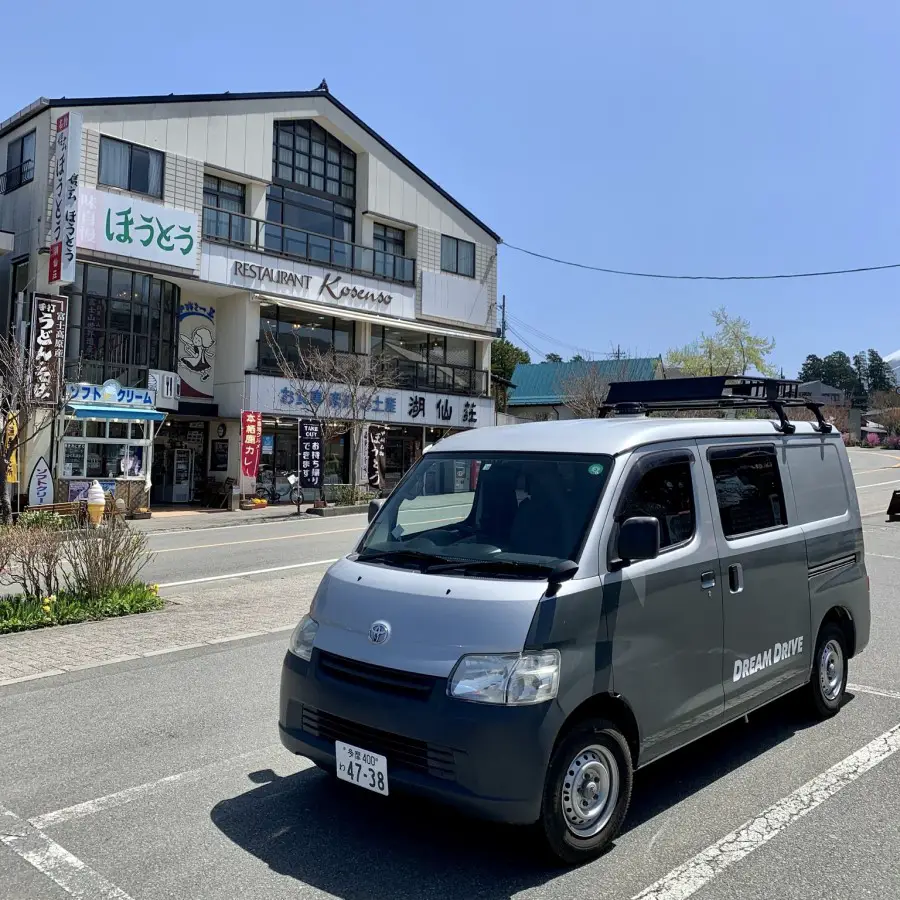
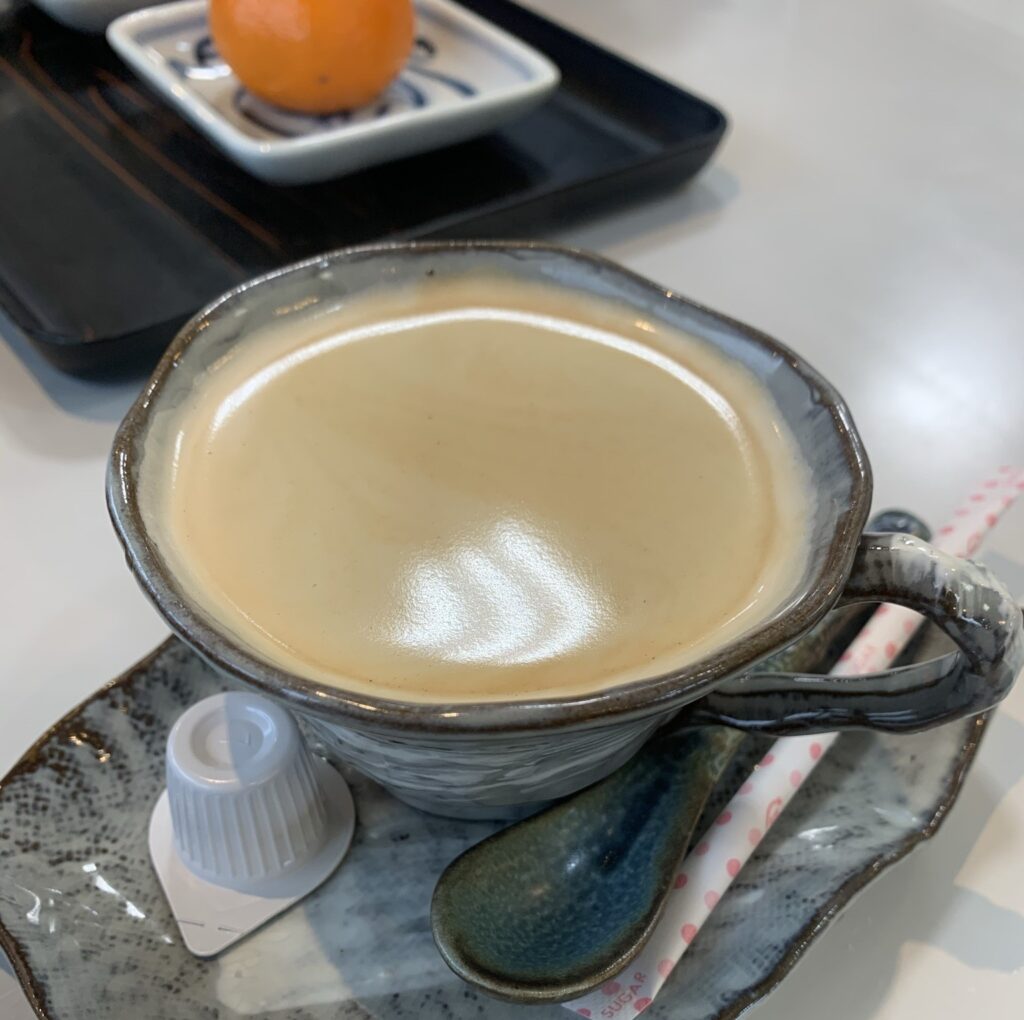
In good weather, you can admire Mount Fuji from the restaurant window, but I’ve never been lucky enough to do so. Apart from the restaurant located on the first floor, there is a gift shop on the ground floor, which is worth taking a look at.
Around Lake Shoji
Overnight stay is not allowed on the beautiful Tatego-Hama beach at Lake Shoji, but… you can drive up to the beach and enjoy the view of Mount Fuji for as long as you like. You can also prepare your lunch here, as we did on the last day of our camper trip, after checking out at 10 AM from Lake Motosu. A drive around this lovely lake is pure fun!
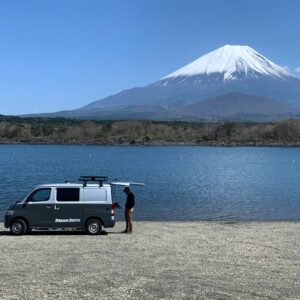
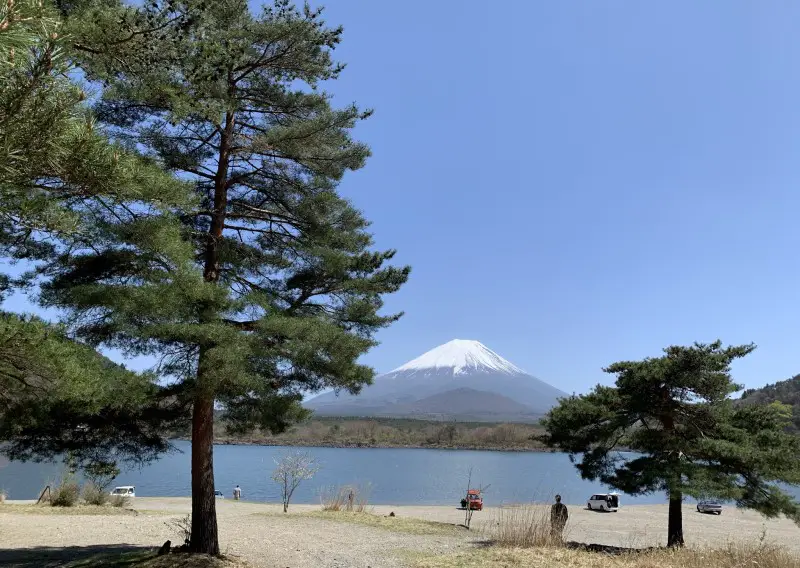
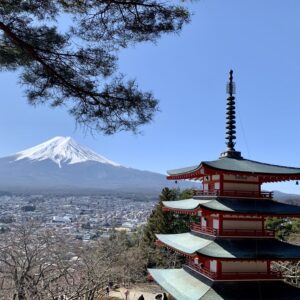
LAke KAwaguchi
Lake Kawaguchi is the most famous and the most developed of the Five Fuji Lakes. There are plenty of attractions, scenic points, interesting temples and good restaurants nearby. It’s a 30 min / 25 km drive from the Kouan campsite, so if you are staying long enough in this area, it’s definitely worth visiting. My favorite way to explore Lake Kawaguchi is by bicycle that can be rented by the lake.
LAke KAwaguchi
Lake Kawaguchi is the most famous and the most developed of the Five Fuji Lakes. There are plenty of attractions, scenic points, interesting temples and good restaurants nearby. It’s a 30 min / 25 km drive from the Kouan campsite, so if you are staying long enough in this area, it’s definitely worth visiting. My favorite way to explore Lake Kawaguchi is by bicycle that can be rented by the lake.

Go to “HOW TO FALL IN LOVE WITH MOUNT FUJI – LAKE KAWAGUCHI IN 2 DAYS” to read more about things to do at Lake Kawaguchi.
Lake Tanuki
Visiting less known Lake Tanuki, which is not classified as one of the famous Five Fuji Lakes and therefore less busy, is another option for a little trip. It is also much smaller than other lakes. For your comparison lakes shore length: Tanuki – 4 km, Shoji – 7 km, Motosu – 12 km and Kawaguchi – 19 km.
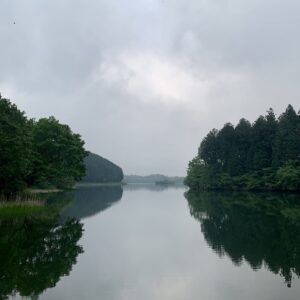
Lake Tanuki, which is an artificial reservoir created by diverting the waters of a nearby river, offers great views of Mount Fuji. It’s the site of the famous spectacle called “Double Diamond Mount Fuji” held at sunrise when the shining sun is directly above Mount Fuji’s top. Each year it can only be observed within one week before and after April 20 and August 20 at around 6AM. The driving time and distance from Lake Motosu to Lake Tanuki, situated in Shizuoka Prefecture, is the same as to Lake Kawaguchi (30 min / 25 km).
4. Practical tips for camping under Mount Fuji at Lake Motosu
4.1. The best time for camping under Mount Fuji
Camping at Lake Motosu is always a good idea. Although it can be done all year round, I always come here in spring – in April or May.
If you want to enjoy the clearest views of Mount Fuji and more tranquility, come in winter. Low temperatures are the price to pay. January is the coldest month of the year with average daily temperatures ranging from 0-6°C.
Spring brings blooming flowers and especially its beginning still means good visibility. The temperatures become pleasant, although nights are still chilly. So, bring your down jacket and make a fire to warm up in the evening. Daily average temperatures in April range from 11-16°C, while in May 16-22 °C.
In summer, especially in August it gets hot with temperatures above 30 °C. Although the visibility is the worst and the views of Mount Fuji are not guaranteed, you can enjoy the warm waters of Lake Motosu, rent a kayak or a stand up paddle board (SUP).
Autumn is also a great time for camping under Mount Fuji.
The region of Five Fuji Lakes is particularly famous for stunning autumn colors. Lower temperatures mean clearer sky and better visibility.
4.2. Where to do the grocery for camping under Mount Fuji?
Supermarket MaxValu Fujikawaguchiko is the most convenient place to do the grocery for the best camping experience under Mount Fuji. Located on the way to Lake Motosu, near Lake Kawaguchi on Route 139, this huge supermarket offers all the BBQ items you need from gas bottles to fresh veggies and marinated meat. Free parking is available. Opening hours: 7AM–11:30PM
4.3. Where is the closest convenience store?
Try not to forget anything in the supermarket as there are no convenience stores on Lake Motosu. The nearest Yamazaki shop is on Lake Shoji – 15 min / 10 km drive from the campsite.
4.4. Try not to arrive on busy Saturdays to get the best site
To make the most of your Mount Fuji camping experience at the Kouan Camping Ground where tent sites are not designated, especially on most busy Saturdays, we always leave Tokyo on Friday morning to ensure the best spot right on the lakeshore. However, unless you choose a forest site to enjoy a pleasant shade in the hot summer, all sites at the Kouan Camping Ground offer a spectacular view of Mount Fuji.
4.5. How to camp under Mount Fuji for free?
If you travel on a budget, camping under Mount Fuji for free might be a good option. In Japan, staying overnight at the parking lot is usually allowed. And when it’s not, there is always a visible sign. During the day you can camp on the Tatego-Hama Beach on Lake Shoji, and at night move to the parking lot on the opposite side of the road. There are public toilets, situated between the beach and the parking lot. So, if you want to save some yen, go for it!
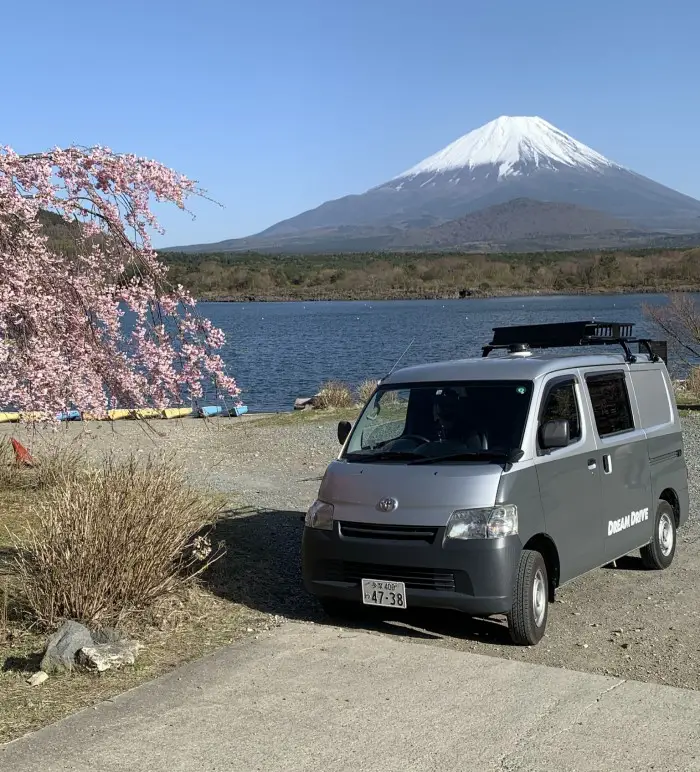
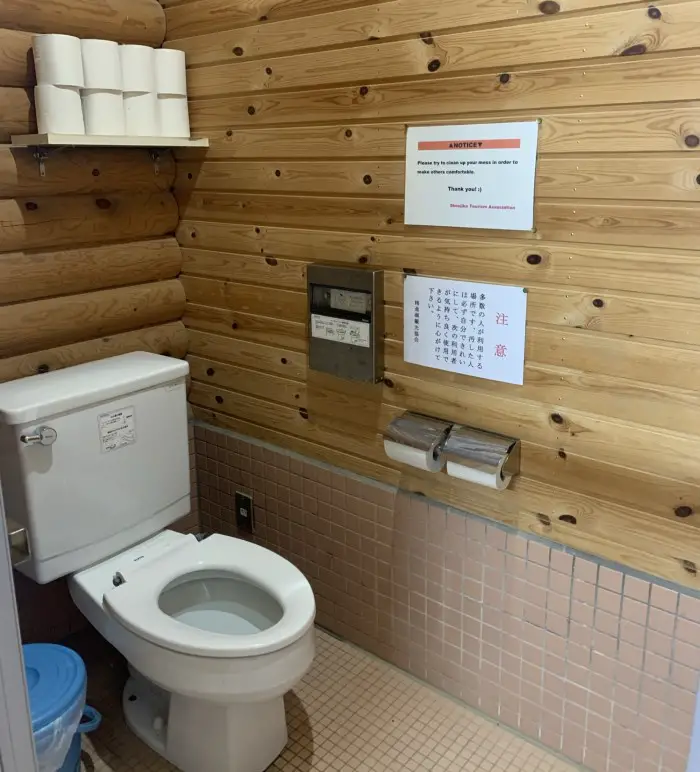
4.6. Manage your expectations to enjoy Mount Fuji camping
Even though I love camping at Lake Motosu, I am also aware of its downsides. First of all, it is very popular and the Japanese are avid campers, so it can be quite crowded. Don’t expect to be alone with Mount Fuji here, unless you come in winter on weekdays. Having said that, to be honest, this is not a big problem for me as I quite enjoy people-watching.
In Japan, most people take camping gear very seriously. They have large and fancy tents, all possible gadgets to make camping life more comfortable and lots of interesting accessories. Last time I came across a family of four with neatly arranged kitchen utensils in front of the tent including seven frying pans, each of a different size. I have fewer pans at home…
In Japan people like to be very well prepared for all possible scenarios and risks. If you want to learn more about the professional approach of Japanese hikers to their mountain gear check out this post (coming soon!).
Secondly, if you are coming with a campervan for more than one night in a busy time, someone might take your site if you leave the campsite with your campervan during the day as there are no designated camping sites. If you come with a tent, it’s not a problem though. Otherwise, you might just need to find a different spot.
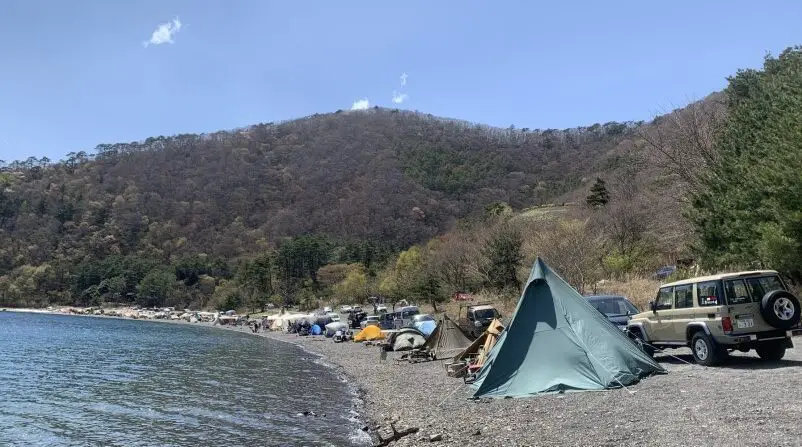
5. Other good campsites around Mount Fuji
5.1. Fumotoppara Campsite
Probably the most famous campsite in all of Japan. Located very close to Mount Fuji, it has over 3,200 reviews on Google Maps and an impressive 4.4 ranking. So, if you are not convinced about lakeside camping, or do not find a vacant place, this spacious grassland campsite may be for you. It is really huge and the view of Mount Fuji is impressive from each camping site. Unfortunately, during my stay, the weather it was very cloudy and Fujisan hid behind a cloud.
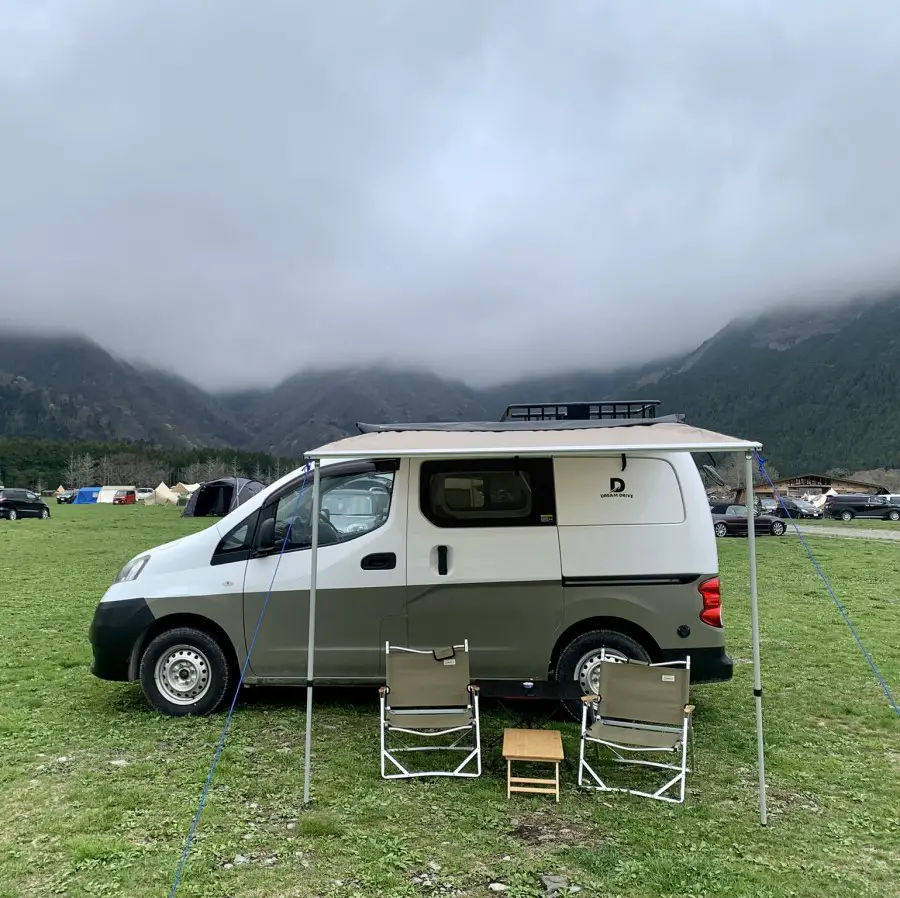
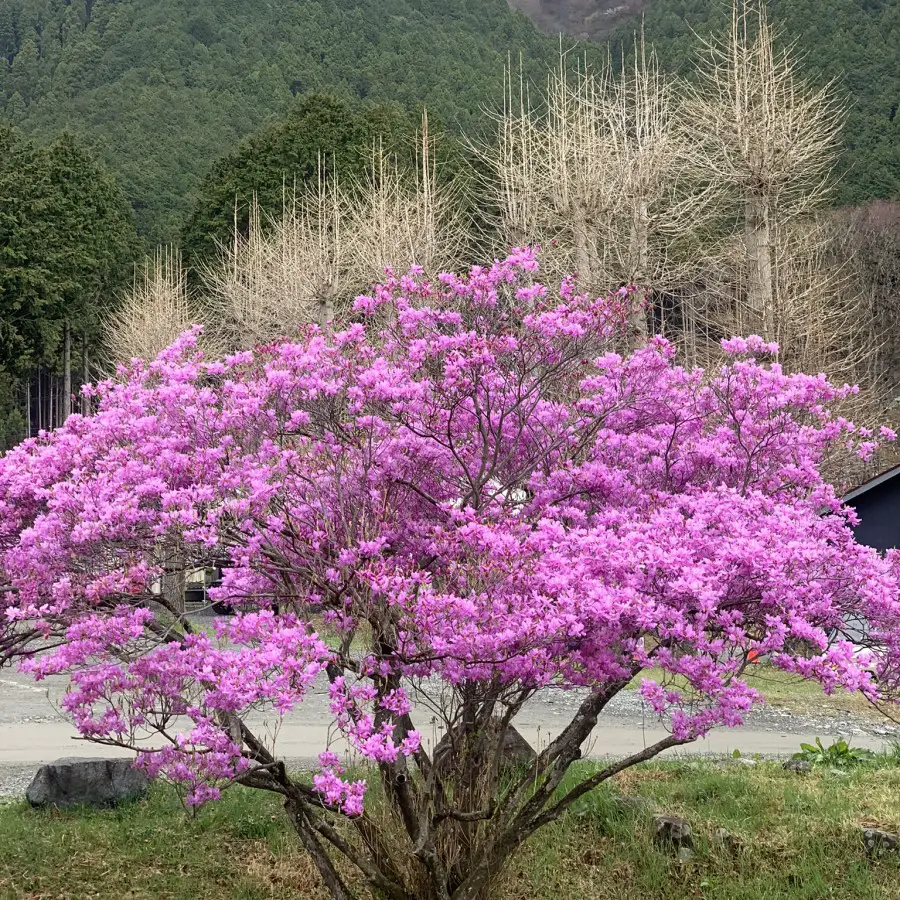
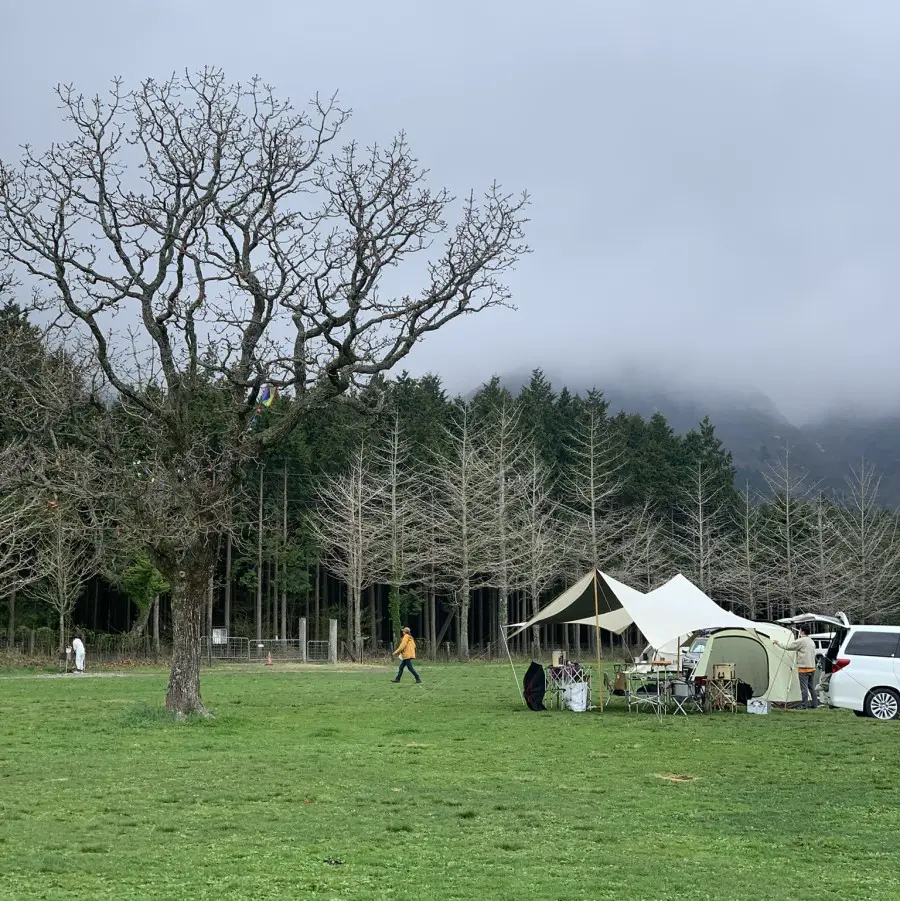
To set up a fire, you need to bring your own trailblazer / portable fire pit as it is not allowed to do it directly on the ground and there is no rental service. Both tents and campervans are permitted. Online booking is possible.
5.2. Cottage Tozawa Center
Situated at Lake Kawaguchi shores, offers awesome views of Mount Fuji. Access by public transport is easy as the bus stop is nearby. I have never camped there but it looks like a nice alternative if only you can get a spot. Campsites are small, so when booking it’s better to confirm if a small campervan can enter. There are also cabins. Online reservation available.
The official website HERE is in Japanese only, so you will need to use Google Chrome translator.
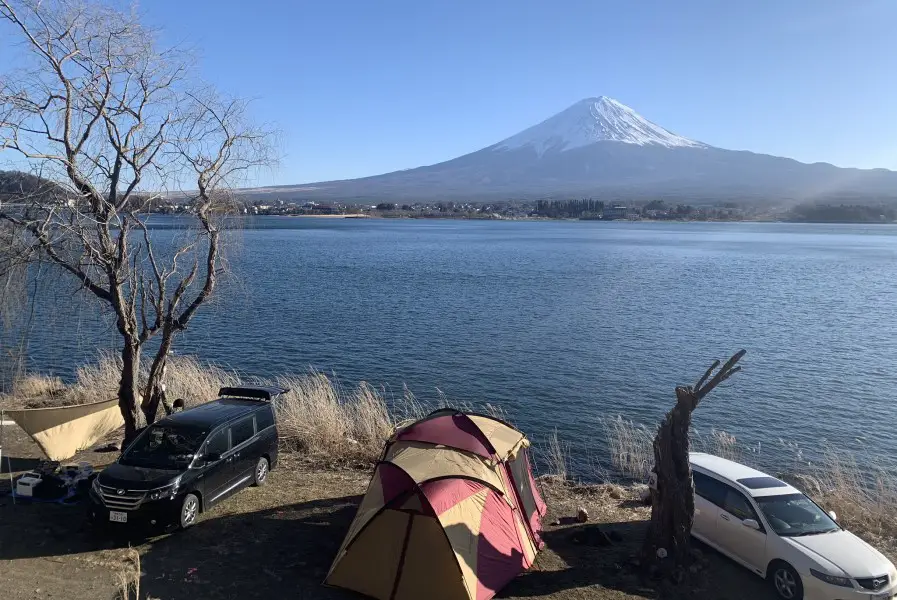
5.3. Lake Tanukiko Campground
Also camping at Lake Tanuki offers amazing views of Mount Fuji. Probably the biggest attraction of staying here, apart from the “Double Diamond Mount Fuji” and the sheer pleasure of camping, is a bike ride along the promenade around the lake. You can also rent a pedal boat or go fishing. Cars must be left in the parking lot, so tents-only.
The official website of Lake Tanukiko Campground – HERE and its Google Maps location – HERE.
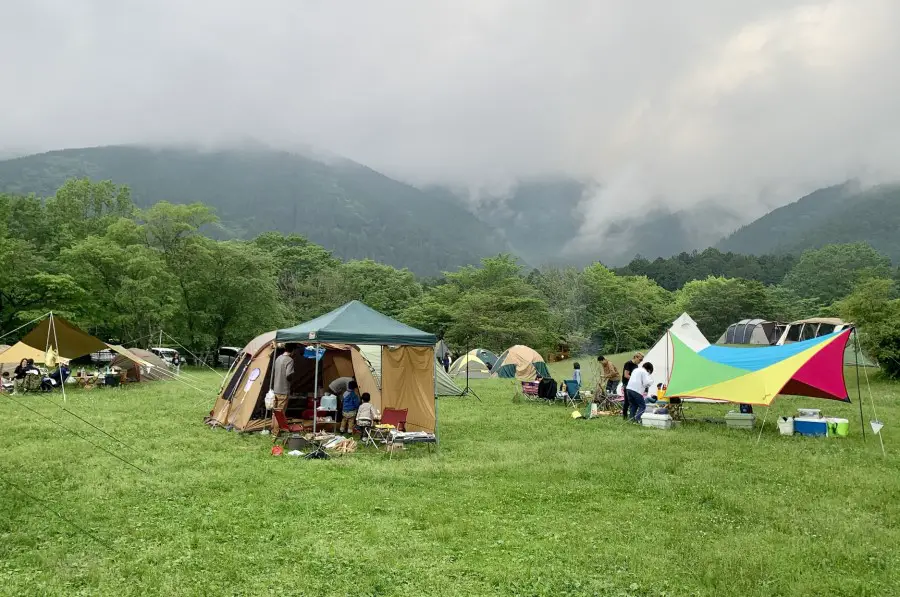
6. Lake Motosu map
After reading this article, you probably already have an idea why I love camping under Mount Fuji so much 🙂 I am very curious if it is also something for you?

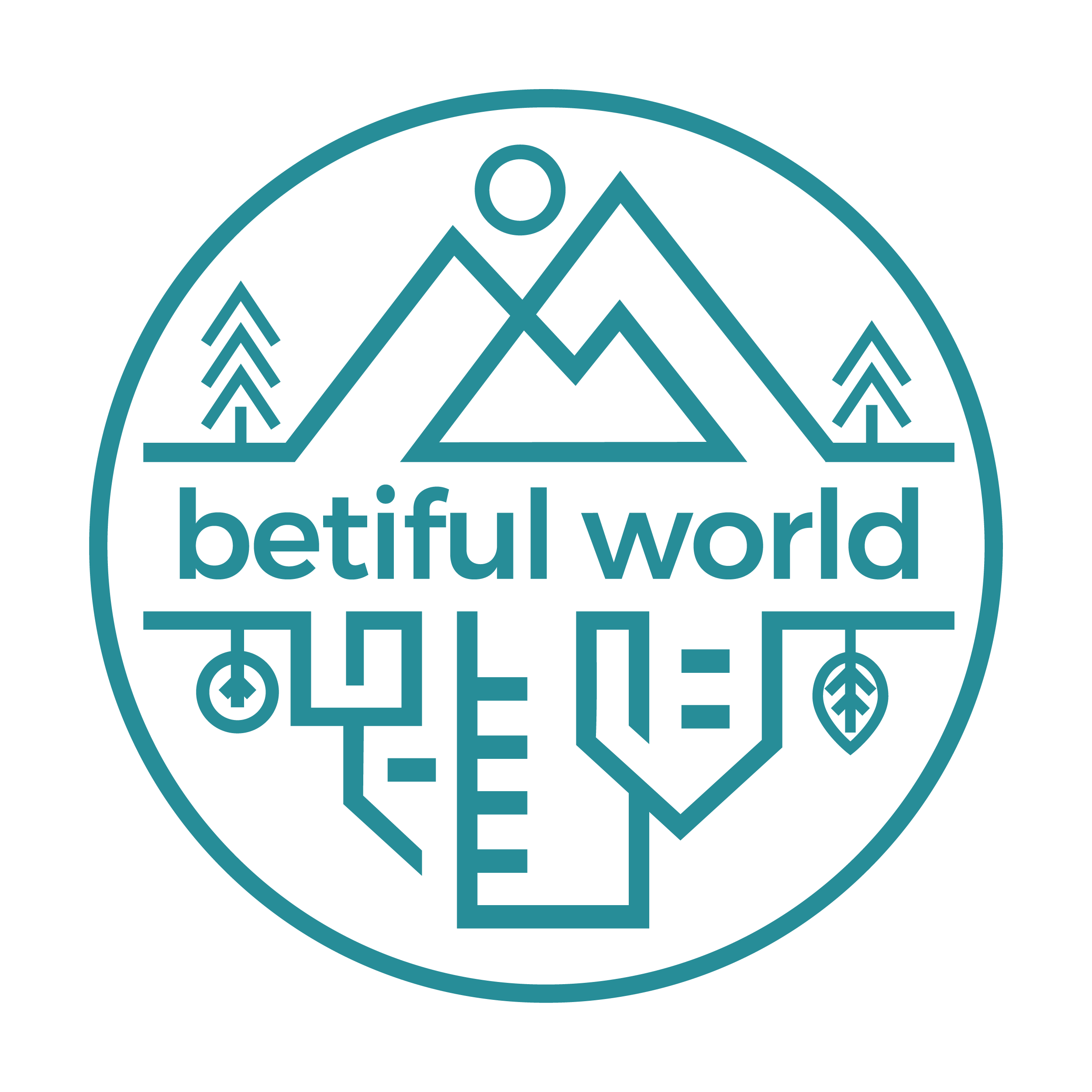










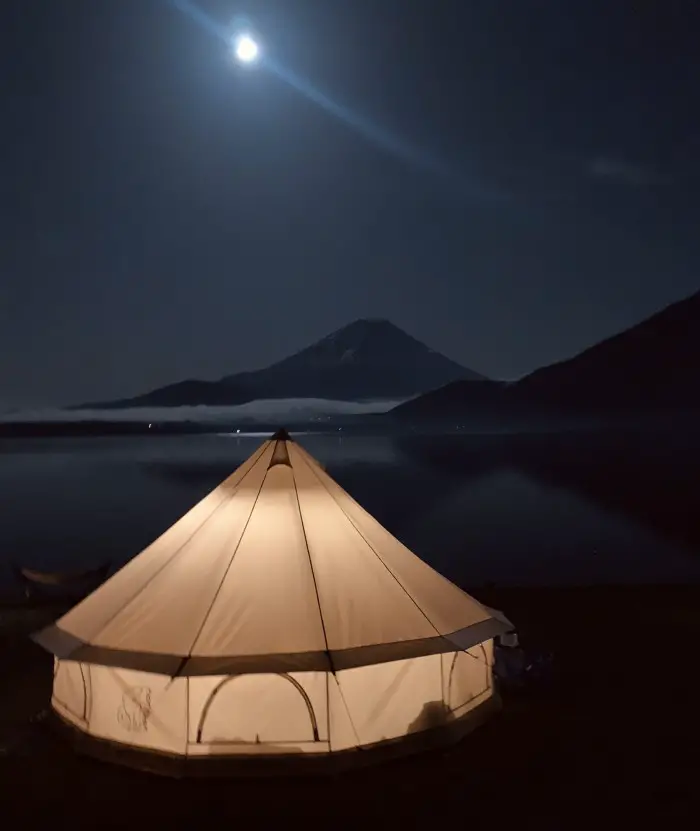
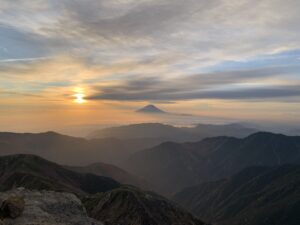
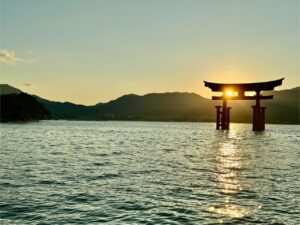
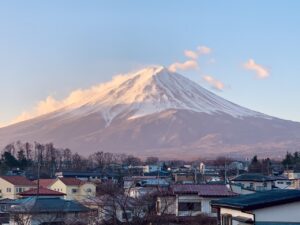
Thank you so much for your useful information. My husband and I are planning to anniversary’s road trip in Japan in winter the end of December 2024. We wish to rent the campervan to travel and stay overnight (2~3 nights) around Mt Fuji and then back to the city. We have no idea and this is the 1st time of camping in Japan. So We have to get so much more information as we can and make a plan.
After reading your blog, We have an idea to start our journey. It must be fun and have a great time.
Thanks again !
Ta from Thailand
Hi Ta!
Thank you for such a nice comment 🙂 It always makes me very happy to know someone finds my writing useful. Good luck with planning! Campervaning in Japan is awesome!
Hello this is great find! Do you know any company that rents camper car around Mt Fuji area? Thank you
Hi Anthony, thank you for your comment and reading my blog. As far as I know, there is none around Mount Fuji. You will have to rent a camper in Tokyo area and drive from there. Any hassle with finding and renting a camper is… worth it 🙂 So good luck!